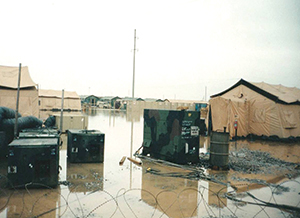When Natalie White found her husband unresponsive the morning after his 41st birthday, she thought it was just another bump in what had been a very rough road. She assumed he’d wake up like he had before when something similar happened.
At 30 weeks pregnant with what she calls their miracle baby, White couldn’t fathom anything different.
“I should have known he was already gone,” she said.
Air Force veteran Clayton White never woke up. His death followed years of mysterious illnesses that Natalie believes were linked to his service at a U.S. military base contaminated with a litany of known toxins.
Between 2001 and 2005, more than 15,000 service members deployed to Karshi-Khanabad Air Base in Uzbekistan in support of military operations into northern Afghanistan following 9/11. Known as K2 or Camp Stronghold Freedom, the former Soviet air base contained residuals of chemical weapons, radioactive depleted uranium and jet fuel, among nearly 400 other chemical compounds.
 The Department of Defense knew that service members there were exposed to dangerous toxins, and a 2015 U.S. Army study found that K2 veterans have a 500% greater chance of developing certain cancers. Hundreds of veterans surveyed by the Stronghold Freedom Foundation—a nonprofit that advocates on behalf of toxic-exposed K2 veterans—reported illnesses ranging from neurological and autoimmune in nature to respiratory and urological.
The Department of Defense knew that service members there were exposed to dangerous toxins, and a 2015 U.S. Army study found that K2 veterans have a 500% greater chance of developing certain cancers. Hundreds of veterans surveyed by the Stronghold Freedom Foundation—a nonprofit that advocates on behalf of toxic-exposed K2 veterans—reported illnesses ranging from neurological and autoimmune in nature to respiratory and urological.
Still, the Department of Veterans Affairs does not recognize the majority of K2 exposures. Even the recently enacted PACT Act—the most comprehensive toxic-exposure veterans bill in history and one DAV was instrumental in pushing through—does little for K2 veterans.
“While the PACT Act includes K2 veterans in the burn pit presumptives, the VA still has not recognized the other toxic exposures and potential diseases unique to K2,” Deputy National Legislative Director Shane Liermann said. “Because of these gaps, many veterans will be denied access to life-changing health care and benefits.
“That’s why DAV, veterans and their survivors will continue to fight for recognition and meaningful action.”
‘This place is toxic’
When Mark Jackson deployed to K2 in summer 2003, he kept daily journals. Dozens of neon yellow tabs protrude from the pages, marking each day he felt sick.
“The very first thing I write about is my throat and my eyes stinging from … this rotten smell,” said the Army veteran, who now serves as the acting executive director for the Stronghold Freedom Foundation. “The next day, my journal entry said, ‘This place is toxic.’”
Jackson soon found himself logging various symptoms: coughs, headaches, rashes, shortness of breath, fatigue.
“We called it the ‘Karshi crud,’” DAV member and Air Force veteran Andrea LaForce said.
LaForce deployed to K2 in 2003, more than a decade into what would become a 29-year military career. Along with the Karshi crud, she developed eczema while at K2.
K2’s toxicity wasn’t a secret. Signs warned of chemical agents and radiation hazards. A pond ominously changed colors, earning the moniker “Skittles Pond.” In some places, black goo emerged from the ground. And, as if transported into a sci-fi movie, Jackson and LaForce remember when workers dressed in hazmat suits and carrying Geiger counters visited the base.
But LaForce said she figured any potential exposures were a fair trade-off. After all, they weren’t being shot at, and the aircraft returned relatively safely. Jackson said that, despite the clear signs of danger, he’d do it all over again.
“And I don’t know anyone who wouldn’t,” he said. “The basic terms of service when you sign up are that you’re going to give all the way up to and including your life, but they’re going to take care of you and your family. And they’re not honoring their end of the bargain.”
‘Wheels coming off’
Soon after leaving K2, and at just 27 years old, Jackson’s thyroid effectively died. At 30, he was diagnosed with irritable bowel syndrome. At 43, his doctor told him he had the bones of an 80-year-old.
Last summer, he was hospitalized for a month due to a blood infection. Treatment required three surgeries and a catheter to his heart.
“I’m 45 years old, and I’ll go ahead and assume that I’m pretty well beyond middle-aged at this point based on the wheels coming off,” he said.
Jackson has only received a service connection and a disability rating for his thyroid. That means it’s up to him to cover the costs of treatments for his other conditions, whether out of pocket or through private insurance.
Six months after leaving K2, LaForce suffered severe abdominal pain caused by a large ovarian cyst that burst. Nearly 20 years later, she continues to develop cysts and experience chronic pain. Her condition is manageable but takes constant care and monitoring. LaForce is also keenly aware that it could one day develop into ovarian cancer.
She received service connection for the ovarian cysts but with a 0% disability rating.
“While I’m thankful I haven’t had cancer and haven’t had some truly debilitating issues, chronic pain ain’t no joke either,” she said.
White said her husband Clayton looked like a “shell of a person” when he returned from K2. His watch spun around his wrist, an indication of how much weight he’d lost. Soon after, he started suffering from migraines and couldn’t concentrate on tasks he once enjoyed.
The list of Clayton’s ailments came to include thyroid disease, chronic hypertension, gastrointestinal issues, seizures, respiratory problems, pancreatitis and tinnitus.
“I became his caregiver,” White said. “We had to change our lives completely around.”
Clayton only received a service connection for tinnitus. In the wake of his death, his wife has been unable to obtain survivors benefits as she raises the daughter he never had the chance to meet.
The time is now
In the years since the U.S. ceased operations at K2, much has been learned about the toxic exposures there, but little has been done. In 2020, at the urging of Congress, the DOD declassified K2 environmental hazard surveys and health risk assessments. Those documents revealed that, as early as 2001, the government knew about the potential for exposures and the negative health consequences associated with them.
Since then, different measures have called for short- and long-term studies of toxic exposure at K2. Jackson supports those measures but said veterans and survivors need action sooner rather than later.
“The one thing that toxic exposures and diseases like these don’t allow for is time,” he said. “Do the study[ing]. In the meantime, err on the side of the veteran.”
The PACT Act established nearly two dozen presumptive diseases related to burn pit exposure, meaning veterans who served in overseas locations with active burn pits no longer have to prove their exposure or direct service connection for presumptive diseases established by the law. DAV wants the same for K2 veterans.
“Toxic exposures—and specifically recognition of the exposures at K2—will be part of DAV’s critical policy goals in 2023. We won’t stop beating that drum,” Liermann said. “We will seek legislation that concedes K2 exposures, orders studies on those exposures and establishes presumptive diseases.
“And we expect Congress and the VA to act with the urgency required to keep our promise to these veterans and their families.”
For updates on DAV-sponsored K2 legislation and to learn how you can support such measures, join the Commander’s Action Network at DAVCAN.org.






